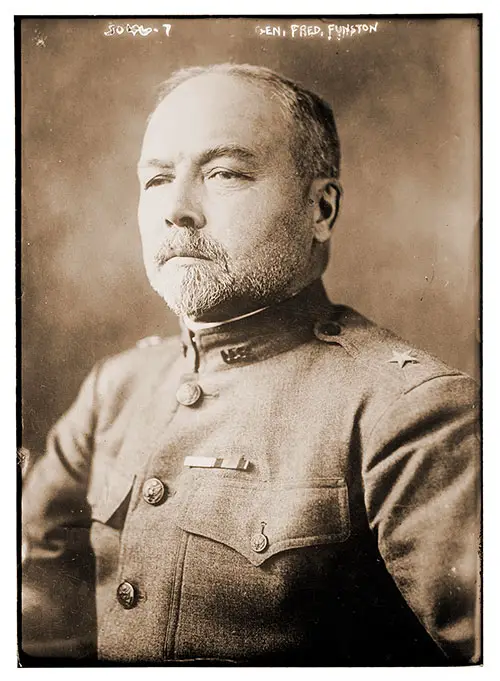Camp Funston - History - 1918

Panoramic View of Camp Funston at Fort Riley, Kansas, 1918. Camp Funston Illustrated, 1918. GGA Image ID # 19cfbfad3e
It devolves on Camp Funston, located at Fort Riley, Kansas, which stands at the Republican and the Kansas rivers' confluence to accommodate the National Army forces from seven States—Missouri, South Dakota, Nebraska, Kansas, Colorado, New Mexico, and Arizona.
The men who will train at this camp may well feel that they are closer to the heart of the United States than any of the other military forces of the nation, for at Fort Riley stands the Ogden Monument, proclaiming the exact geographic center of the United States.
The military reservation on which Fort Riley stands, and on which Camp Funston was built, embraces nearly 20,000 acres. A military road connects Fort Riley with Fort Leavenworth, on the Missouri River, about 25 miles above Kansas City.
This road was completed in 1854. Later it was extended westward to Bridgers Pass, between Nebraska and Utah. Fort Riley is the United States Cavalry, and Field Artillery schools seat, which accounts for the big area embraced in the reservation.
Camp Funston can accommodate 41,000 people—a city as populous as the State capital. To the south of the camp runs the Kansas River and to the north are grass-covered hills. It would be difficult to imagine a more striking location for a camp.
The fertile valley of Kansas' middle river sweeps eastward, and one gets the feeling of the boundless reaches of America as he surveys the scene from the green hills to the north.
The county adjoining Riley on the east is Pottawattomie, home of John Brown. Sixty miles to the southeast is Emporia, where "What's the Matter with Kansas" had its birth.

General Frederick Funston (1865-1917) - ca 1910s. Image Courtesy of the Library of Congress - LC-B2-3046-7. GGA Image ID # 19d4d4752e
Camp Funston is named for General Frederick Funston, who died only a few months ago in San Antonio, Texas. Born at New Carlisle, Clark County, Ohio, in 1865, the son of an artillery officer in the Civil War, his boyhood was spent on a Kansas farm.
He was educated at the State University, became a reporter and then a special agent of the United States Department of Agriculture, where his work took him across Death Valley, into the heart of Alaska, down the Yukon alone in a canoe and up the Lost meridian to the Arctic Ocean. Later he traveled to Mexico, then went to Cuba, where he joined the cause of Cuba as a captain of artillery.
While campaigning with Gomez and Garcia, he was wounded, and seeking to return to the United States, was captured by the Spaniards, who condemned him to be shot.
Upon being released, he returned to the United States. At the outbreak of the Spanish-American War, he raised the 10th Kansas Volunteer Infantry Regiment.
He was sent to the Philippines, where, on a small raft, he crossed a river under heavy fire and established a rope ferry that enabled the Federal forces to win an important victory at Calumpit.
For this bravery act, he was awarded the Congressional Medal of Honor and later organized the expedition that captured Aguinaldo. His more recent services, especially as commander of the American forces on the Rio Grande and as the head of the expedition to Vera Cruz, are well known.
